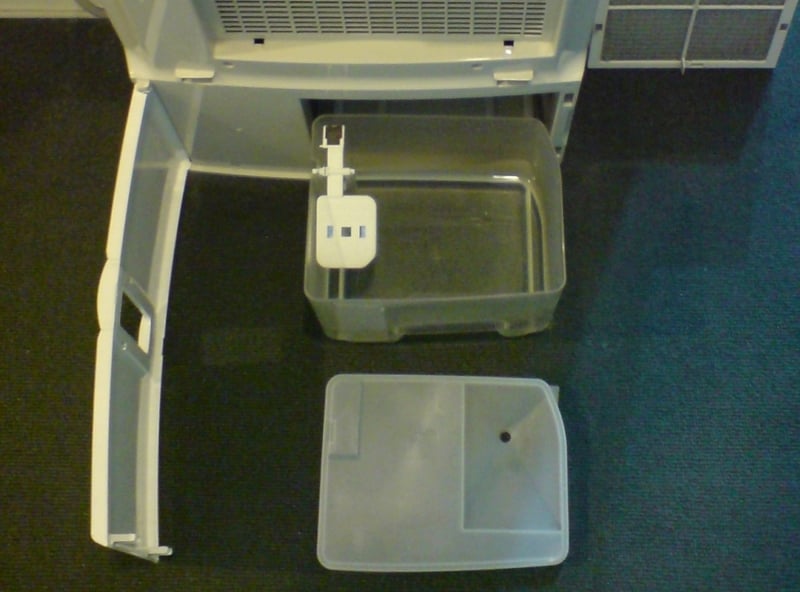Last Updated on January 1, 2024
Most dehumidifiers commonly used and bought are refrigerant type. Thereby their principle of working is almost similar to ACs and Refrigerators. During transportation, storage or lack of space you may have to tilt or lay them. This may hurt your dehumidifier if done without following guidelines.
Laying your dehumidifier on its side or back can lead to compressor failure, clogged filter drier, damaged internal components and inhibit refrigerant state changes. To prevent this keep it upright from 2 to 24 hours before turning it ON, depending upon refrigerant setting time, and never run your dehumidifier in other than upright position.
Not always it is possible to keep dehumidifier in the upright position. Similarly, sometimes you may have to transport it in an inclined or laid down position.

In these cases, you have to take measures before and after laying it down to prevent temporary or permanent damage to your dehumidifier. Worry not, I plan to discuss each and every aspect of it and exactly what you need to do to in this situation.
Why Do You Want to Lay Down Your Dehumidifier?
There are two reasons why this question needs to be answered.
First, to realize if there is really an actual need for laying down your dehumidifier.
Let me give you an example. Suppose you use your dehumidifier sometime of the day in the upright position.
However, after using it for the required time, you may like to store it in a horizontal position on its side or back. Or the space reserved for keeping the unit after usage requires it to be tilted at an angle or laid down.

If this is the case, I would strongly advise against it. The reason is when you restore your dehumidifier in standing position and run it right away, this will either make your dehumidifier unit completely inoperable or partially deteriorate its dehumidification capability with time.
If your unit does not break down, it will at least have a negative effect on its life and effectiveness.
The only way to make this work is to leave your dehumidifier in standing position for extended intervals of time after taking it out. This will be very inconvenient for you. After all, what is the use of a dehumidifier if you can’t use it when you need to.
Second, if there is an actual need for inclination of your dehumidifier, what specifically is that need. This is required to know the impact on your dehumidifier and measures to take, to restore it properly and prevent any damage.
It matters what specific reason you are doing this for.
For example, if you are laying your dehumidifier during transportation, it would be different compared to doing so for storage.

In transportation, with the displacement of dehumidifier fluids, there is high possibility of damage to internal components, due to vibration and impact on the road i.e., compressor mounting, fixtures etc.
In storage, much higher possibility of damage will be due to displacement of compressor oil because of long duration of time in laid position.
Compressor oil is viscous and its displacement from compressor to coils is a lot more possible by months of storage compared to 20 mins of travelling.
What Damage Can a Laid Down Dehumidifier Cause?
There are various reasons why you should not place your dehumidifier on its side or back.
Also, as I said earlier, when you do so, reason why you are doing it matters i.e., storage, transportation, space etc.
Similarly, orientation is also a deciding variable for potential damage. It makes a difference if dehumidifier is laid on its back or side. Further, if it is placed on its side, then which side is it i.e., left or right.
Let me briefly tell you why.
For example, it is possible that you have dehumidifier refrigerant lines extending from compressor only in one direction. So, if you place it on the other side, you will prevent displacement of fluids from compressor.
I will try to cover this aspect for you too, in the potential damages, by laying or tilting your dehumidifier, given below.
This will help you realize when the possibility of a particular damage will be higher.
1. Dehumidifier Compressor Damage by Oil Deprivation
Most dehumidifiers used now-a-days are refrigerant type and use similar mechanism to work as ACs and refrigerators. They have refrigerant that goes through vapor compression cycle to cool and extract moisture.
Similar to a refrigerator, one of the most important and basic mechanically moving component in a dehumidifier is compressor.
Oil is vital for correct and consistent operation of compressor. Compressor Oil is required for lubrication, removal of heat and for sealing purpose in a compressor.
When you lay your dehumidifier on its side or tilt it at an angle, compressor is deprived of necessary lubrication oil at certain zones. This causes its components to collide with each other causing wear and tear. Consequently, there is severe damage to components of compressor and eventually it stops working permanently.
Even if compressor is not damaged permanently, depriving its components of oil will highly affect its performance.
Thereby, keeping dehumidifier in other than upright position often and then turning it ON, without leaving for enough time, will cause it to quickly or slowly deteriorate and lose its effectiveness, due to collision in between components and formation of high heat zones.
2. Interference with Refrigerant in Dehumidifier Coils
What I mentioned before was the impact of oil displacement inside dehumidifier compressor.
But there are some problems that this oil will create outside the compressor i.e., in refrigerant coils, by inclination of dehumidifier from default position.
Actually, refrigerant in dehumidifier changes between vapor and liquid state during its journey in between compressor and dehumidifier coils.
For example, refrigerant moving to compressor has to be completely in gaseous state. If it isn’t compressor will undergo what is called wet compression that will reduce its life.
Similarly, when refrigerant moves through condenser coils, it converts from gas to liquid by evolving heat and in evaporator coils it slowly changes from partially liquid state to completely gaseous state.
This change of physical state of refrigerant is important and indicates absorption or release of heat.
When compressor oil interacts with refrigerant inside dehumidifier coils, it will inhibit refrigerant physical state changes between vapor and liquid state, and thereby reduce cooling effectiveness of your dehumidifier.
As a result, performance of your dehumidifier will drastically reduce and there can be potential damage to it.
3. Clogging Filter Drier
Filter drier is a crucial component for consistent working of any refrigerant cooling system, based on refrigeration cycle.
The purpose of filter drier is to get rid of contaminants and moisture from the refrigerant. Small quantities of lubricant oil that travels with refrigerant are also captured by filter drier.
When you tilt your dehumidifier at an angle or rotate it all the way to horizontal position, compressor oil travels into dehumidifier coils and eventually to filter drier.
Filter drier is designed to contain only small quantities of oil at a time, if they travel with the refrigerant. A large quantity of oil moving into filter drier by laying dehumidifier on its side will cause it to clog.
This will severely reduce effectiveness of your dehumidifier due to restriction to refrigerant by clogged filter drier and its inability to extract contaminants and moisture.
4. Damage to Internal Components
Another possible damage by laying down your dehumidifier could be damage to internal fixtures, components and mountings.
This is not so likely when you slowly tilt it in the horizontal position for storage. Its possibility is higher with transportation or sudden movements.
For example, when your unit is on a delivery vehicle to be delivered to you, sudden jerks may damage its internal setup.
Dehumidifier coils are very sensitive and can be damaged easily by impact. Resultantly, you could have a refrigerant leakage. Then the only option would be to change the coils entirely.
5. Losing Ability to Store Condensate
A not-so-risky but messy problem by tilting your dehumidifier could be spilling of water from dehumidifier bucket.
If your unit is not in upstanding position, condensate water will follow direction of gravity and spill on floor.

Even if your dehumidifier is not laid down completely on its back or side but slightly tilted, water from bucket may drop eventually after filling. Usually this is a consequence of forgetfulness.
Your dehumidifier bucket is designed to work with the unit only in complete vertical upstanding position.
How Long to Leave Dehumidifier After Storage or Transportation?
You had no other choice but to lay your dehumidifier or tilt it from the default position.
Now what?
Keep your dehumidifier in vertical upstanding position for a couple of hours.
The time interval for leaving your dehumidifier, before turning it ON, after restoring to vertical position from inclined position, extends from 2 to 24 hours.
The reason, why different manufacturers recommend different number of hours, to leave your dehumidifier, is dissimilar setting time of oil and refrigerant after displacement.
This setting time depends on several variables including type of refrigerant, compressor oil, configuration of dehumidifier internal setup etc.
For example, for many Honeywell dehumidifier models, including TP30, TP50, TP50H, TP70, TP70P, recommended upstanding time is 4 hours, if the unit was tilted upside down or on its side during transportation.
While for Whynter Elite D–Series Dehumidifiers, recommended upstanding time after transportation is only 2 hours.
Most manufacturers recommend 24 hours upstanding time after keeping dehumidifier in laid position.
My recommendation is to check user manual for this information. It will surely contain instructions about upstanding time after rotation of unit.
If you are not able to obtain this information, I advise to take upper limit and leave dehumidifier for 24 hours in default upstanding position, before turning it ON, after it has been in laid or inclined position.


